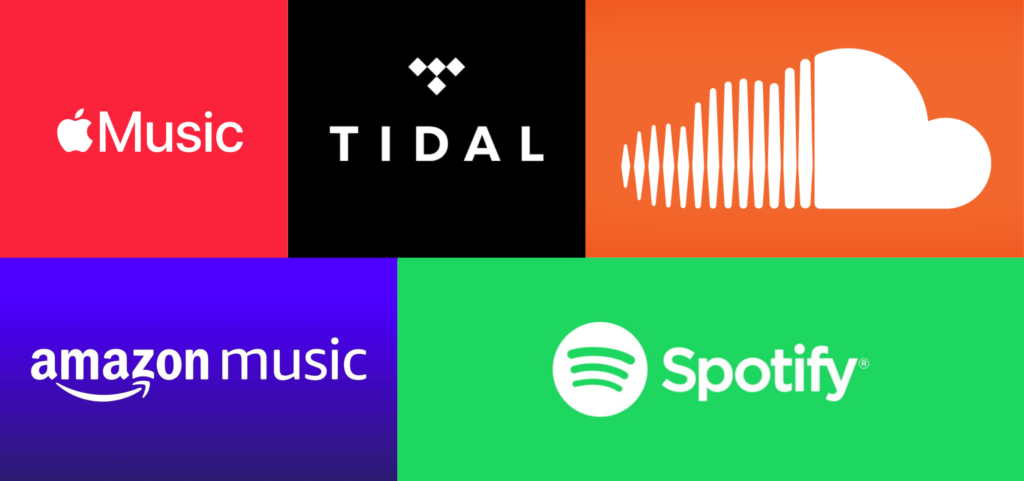The Powerful Impact of Music Streaming On The Music Industry
In an era dominated by technological advancements, the music industry has witnessed a profound transformation with the rise of music streaming services.
Streaming platforms have revolutionized the way people consume and discover music, leading to significant shifts in revenue models, accessibility, distribution channels, and more.
This article explores the impact of music streaming on the music industry and its various implications.
Rappers That Get Help With Writing Songs
The Growth of Music Streaming
The past decade has witnessed an exponential growth in music streaming, with platforms such as Spotify, Apple Music, and Amazon Music leading the way.
According to industry reports, streaming accounted for the majority of music industry revenue in recent years, surpassing physical sales and digital downloads.
This surge in popularity can be attributed to the convenience, affordability, and vast music libraries offered by these platforms.
Music streaming platforms have disrupted the traditional model of physical media and digital downloads by offering a user-friendly and accessible alternative.
Users can stream music on their smartphones, tablets, computers, smart speakers, and other connected devices with ease. The on-demand nature of music streaming allows listeners to create personalized playlists, explore new artists, and discover music from various genres, eras, and cultures.
This has made music consumption more affordable and appealing to a broader audience, including those who may have been hesitant to spend money on physical media or downloads.
Another reason for the growth of streaming services is the affordability. Compared to the cost of purchasing individual albums or songs, the subscription fees for music streaming are relatively low, providing subscribers with unlimited access to vast music libraries.
Despite its benefits, music streaming has been subject to various challenges and controversies. One significant concern is fair compensation for artists and songwriters.
Streaming platforms have faced scrutiny over royalty distribution and the low streaming rates they offer. Moreover, the dominance of streaming has contributed to the decline of album releases, as listeners tend to focus more on individual songs, leading to a shift in the music landscape and artists’ creative decisions.
Changing Revenue Models
The advent of music streaming has brought about a paradigm shift in revenue models within the music industry.
Traditional revenue sources, such as physical album sales and radio airplay, have faced significant challenges, while subscription-based streaming services have emerged as the dominant force in generating income for artists and record labels.
However, this transition has not been without its challenges, as artists and labels grapple with new ways of monetizing their content and adapting to a rapidly evolving landscape.
Physical Album Sales:
Historically, physical album sales, including CDs and vinyl records, constituted a major source of revenue for artists and record labels. Fans purchased albums to own physical copies of their favorite music, contributing to artists’ earnings and record label profits.
Radio Airplay and Performance Royalties:
Artists earned revenue from their music being played on radio stations and public performances, such as concerts and live shows. Performance royalties collected by organizations like ASCAP and BMI compensated artists and songwriters for the public use of their music.
Digital Downloads (New Model):
With the rise of digital technology, digital downloads on platforms like iTunes became another revenue stream. Consumers could purchase individual songs or entire albums digitally, allowing for more convenient access to music.

Introduction of Subscription-Based Streaming and Its Impact on Revenue
Subscription-based streaming services, such as Spotify, Apple Music, and Tidal, have transformed the music industry by offering users unlimited access to vast music catalogs for a fixed monthly fee. Subscribers can stream songs, create playlists, and download music for offline listening.
The subscription-based model has ushered in a stable and predictable revenue stream for artists and record labels.
Instead of relying on one-time album sales, they now receive recurring income based on the number of streams their music generates.
The introduction of music streaming has contributed to a rebound in global music industry revenue after years of decline. Streaming has become the largest revenue source, surpassing physical sales and digital downloads, allowing the music industry to experience renewed growth.
The Rise Of Afrobeats Around The World
Increased Accessibility to Music Through Streaming Platforms
Music streaming platforms have significantly enhanced the accessibility of music for listeners worldwide.
Unlike traditional distribution methods that relied on physical media or limited digital downloads, streaming allows users to access an extensive library of songs, albums, and playlists at any time and from any location with an internet connection.
This unprecedented accessibility has transformed the way people consume music, making it more convenient and immediate.
With music streaming, listeners no longer need to wait for physical albums to be released or visit stores to purchase music. They can instantly search for and play their favorite songs, providing instant gratification and an immersive music experience
The on-demand nature of music streaming allows users to create and curate their playlists, enabling them to personalize their music listening experience according to their moods, preferences, and activities.
Expansion of the Global Audience and Reach for Artists
Music streaming has erased geographical barriers, enabling artists to reach a global audience like never before. This has had a profound impact on both established artists and emerging talents, democratizing the music industry and providing a platform for diverse voices to be heard.
- Global Distribution: With music streaming, artists’ work is instantly available to listeners worldwide. This global distribution has facilitated the internationalization of music scenes, exposing artists to audiences from different cultures, countries, and backgrounds.
- Cultural Exchange: Music streaming has fostered a cultural exchange, allowing listeners to explore and appreciate music from different regions and traditions. Artists from diverse backgrounds gain opportunities to showcase their artistry and enrich the global music landscape.
- Breaking Language Barriers: Streaming platforms have broken language barriers, promoting songs in various languages. International hits and collaborations between artists from different countries have become more common, promoting cultural exchange through music.
Rap Artist In Prison Right Now
Opportunities for Niche Genres and Independent Artists to Gain Exposure
Prior to music streaming, niche genres often struggled to find a broad audience due to limited exposure and distribution.
Independent artists faced challenges in securing deals with major record labels. However, music streaming has leveled the playing field, creating opportunities for lesser-known genres and independent artists to gain significant exposure and recognition.

A streaming platforms algorithms expose users to music outside their typical listening patterns, allowing niche genres and artists to be discovered by wider audiences. This increases the chances of independent artists gaining exposure to new fans.
Curated playlists have become a vital tool for artists to gain exposure. Music curators and influencers on streaming platforms often feature tracks from emerging artists, helping them reach audiences interested in specific genres or themes.
Streaming platforms enable artists to connect directly with their fans through social features and playlists. This direct engagement fosters a loyal fan base and facilitates organic growth for independent artists.
Impact on Brick-and-Mortar Music Stores and Record Labels
The disruption of traditional distribution channels has had significant consequences for brick-and-mortar music stores and record labels. As streaming became the dominant method of music consumption, these entities faced challenges in adapting to the new digital landscape.
Challenges for Music Stores: Brick-and-mortar music stores, once thriving centers for music enthusiasts, have experienced a decline in foot traffic and sales due to the popularity of streaming. Many music retailers have either closed down or diversified their offerings to survive in the digital age.
Transformation of Record Labels: Record labels have had to adjust their strategies and business models to accommodate the shift to streaming. While they now focus more on digital marketing and playlist promotion, they have also developed partnerships with streaming platforms to ensure their artists gain visibility in curated playlists.
Impact on Physical Releases: As physical sales dwindled, record labels reduced their investment in physical releases. Some artists and labels now opt for limited-edition vinyl releases to cater to collectors and dedicated fans while primarily focusing on digital distribution.
Digital Audio Workstation Information
Rise of Playlist Culture and Its Influence on Music Consumption
The rise of music streaming has given birth to a playlist-centric culture, where curated playlists and user-generated playlists significantly influence how people discover and consume music.
Streaming platforms curate playlists for various moods, activities, genres, and themes. These playlists have become instrumental in music discovery, as users turn to them for a continuous flow of music tailored to specific preferences.
Securing placements on popular playlists has become an essential marketing strategy for artists and record labels. Songs featured in prominent playlists can experience a surge in streams, leading to increased visibility and potential success.
Streaming platforms allow users to create their playlists, enabling them to become “curators” and share their music selections with others. This social aspect of music streaming fosters a sense of community among users with similar musical tastes.
Playlist culture has influenced artists’ release strategies. Some artists now focus on releasing singles and EPs to gain traction on playlists and maintain a consistent presence on streaming platforms, rather than adhering to the traditional album release cycle.
Download Your Favorite Music From Soundcloud
Data and Analytics in the Music Industry
Data and analytics have become integral components of the modern music industry, with streaming platforms leveraging user data to offer personalized experiences and improve their services.
The vast amount of data collected from users’ listening habits, preferences, and interactions allows streaming platforms to make informed decisions and tailor their offerings.
Streaming platforms employ sophisticated algorithms that analyze user data to provide personalized recommendations. These algorithms consider factors such as listening history, user-generated playlists, and user interactions to suggest songs and artists aligned with each user’s tastes.
By understanding user demographics and preferences, streaming platforms can deliver targeted advertising to users, creating a more relevant and engaging advertising experience while also maximizing ad revenue.
Benefits and Challenges for Artists, Labels, and Marketers in Leveraging Data
The availability of data and analytics presents both opportunities and challenges for artists, record labels, and marketers in the music industry.
While data-driven insights can provide valuable benefits, effectively leveraging this information requires a comprehensive approach.
- Audience Insights: Data analytics offer artists and labels valuable insights into their audience’s demographics, geographic distribution, and listening behaviors. This knowledge enables them to better understand their fanbase and tailor their marketing and promotional strategies accordingly.
- Music Promotion and Playlist Placement: Artists and labels can use data to identify which songs are performing well on streaming platforms. This information can guide them in choosing which songs to promote and pitch to curators for playlist placement, potentially leading to increased visibility and streams.
- Tour Planning and Fan Engagement: Data can help artists plan tour locations based on their fanbase’s geographic distribution. It also aids in optimizing social media and digital marketing efforts to engage with fans and promote events effectively.
- Data Privacy and Transparency: While data analytics can provide numerous benefits, there are concerns about data privacy and transparency. Streaming platforms must navigate ethical considerations and ensure that user data is protected and used responsibly.
- Balancing Artistic Expression with Data: As artists and labels utilize data to inform their decisions, there is a delicate balance between catering to audience preferences and preserving artistic authenticity. Striking this balance is crucial to maintaining a meaningful connection with fans.
Challenges and Controversies in Music Streaming
I touched on it a bit earlier but let me go in depth on the challenges and controversies in music streaming.
One of the most significant challenges and controversies in the music streaming era revolves around the compensation of artists and songwriters.
While streaming has become the dominant method of music consumption, there are concerns about the fairness of the royalty payments received by creators.
Streaming platforms typically pay artists and songwriters based on the number of streams their music receives. However, the per-stream royalty rates are often relatively low, leading to criticism from artists who argue that they are not adequately compensated for their work.
The distribution of streaming revenue is often skewed in favor of major artists and labels, leaving independent artists with a smaller share. This disparity raises questions about equitable compensation and fair treatment for all creators, regardless of their level of popularity.
The complexity of royalty distribution systems can make it challenging for artists and songwriters to track and understand their earnings accurately. This lack of transparency can lead to confusion and frustration among creators.
More needs to be done to raise the payout to artist and it will only change if all the artists come together and handle this situation in court.

Technological Advancements In Music Streaming
Technological advancements may lead to improvements in audio quality, offering listeners higher fidelity streaming options.
High-resolution audio and immersive formats like spatial audio could become more prevalent, providing a more immersive and engaging music experience.
Music streaming platforms might incorporate AR and VR technologies to create interactive and visually engaging experiences. Virtual concerts, 360-degree music videos, and virtual meet-and-greets with artists could become part of the streaming landscape.
We’re already experiencing it, but in the future you can also expect AI playing a more significant role in music creation, assisting artists in composing, producing, and even personalizing music based on listener preferences.
AI-generated playlists and music tailored to individual tastes might become more common.
Blockchain technology could revolutionize music streaming by enhancing transparency, simplifying royalty distribution, and ensuring fair compensation for artists. Decentralized music streaming platforms might emerge, giving artists more control over their content and revenue.
Collaboration Between Artists and Streaming Platforms
Streaming platforms may engage in more exclusive content deals and collaborations with artists, offering special releases, behind-the-scenes content, and unique experiences to attract and retain subscribers.
Interactive Fan Engagement: Streaming platforms might facilitate closer interactions between artists and fans, allowing artists to engage with their audience through live streams, Q&A sessions, and virtual fan events.
Co-Creation and Curation: Artists could play a more active role in co-creating and curating playlists, offering listeners a more personal and authentic music experience.
Monetization Diversification: Streaming platforms may explore new ways to monetize their services beyond subscriptions and advertising. For instance, platforms could offer tiered subscription plans with additional benefits or introduce microtransactions for exclusive content.
Integration with Other Media: Streaming platforms may integrate with other media, such as video streaming services or gaming platforms, to offer a more comprehensive entertainment experience for users.
Data Privacy and Regulation: As data privacy concerns grow, streaming platforms might face increased regulation regarding data collection, usage, and transparency to safeguard users’ information.
Hybrid Models: Some platforms may adopt hybrid models that combine streaming with other revenue streams, such as merchandise sales, ticketing, and crowdfunding, to support artists more effectively.
Conclusion
In this comprehensive exploration of the impact of music streaming on the music industry, several key points have emerged.
We discussed the remarkable growth of music streaming, its transformation of revenue models, and the challenges faced by artists and record labels in adapting to this new landscape. We also examined how streaming has enhanced accessibility and global reach, providing opportunities for niche genres and independent artists to gain exposure.
Additionally, we delved into the influence of data and analytics in the industry, the disruption of traditional distribution channels, and the emergence of personalized recommendations and curated playlists.
As the music industry moves forward, music streaming services must grapple with the implications of data privacy, artist compensation, and platform sustainability. Finding equitable solutions and striking a balance between innovation and ethical practices will be vital in creating a vibrant and sustainable music streaming ecosystem.
Sponsor: Best Music Streaming Services



